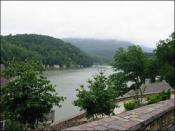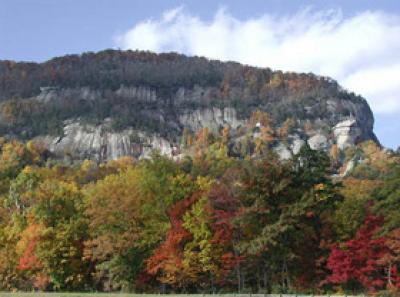Lake Lure Yesterday & Today
With regard to the lake, its trustee is the Town of Lake Lure, and as such, the Town recognizes that the community's primary asset of the trust is the lake itself. The obligation of the town to protect Lake Lure is no different from the obligation of the state to protect state trust resources.
History Of The Lake:
The vision of a resort community in Western North Carolina was the vision of Dr. Lucius B. Morse. Poor health brought Dr. Morse to the Gorge, and it was from Chimney Rock in the early nineteen hundreds that the vision of a lake and a resort development was spawned. The resort was to be developed by Chimney Rock Mountains, Inc. The centerpiece of this resort was to be a lake created by impounding the Rocky Broad River at Tumbling Shoals. This lake was to become Lake Lure. Though the name "Lake Lure" has always been attributed to Dr. Morse's wife Elizabeth, Dr. Morse was using the name "Lure" in his Chimney Rock promotional materials before the lake project began.
Soliciting the financial backing of his brothers, Hiram and Asahel, Dr. Morse proceeded to purchase Chimney Rock (400 acres) from Jerome Freeman in 1902 for $5,000 in the name of Chimney Rock Mountains, Inc. Subsequently; the company acquired enough acreage in what is now the Lake Lure area to bring the total to 8,000 acres or 12.5 square miles, including the valley in which Lake Lure lies and the hills and mountains above.
Dr. Morse and his wife Betty continued to formulate his plans for the property. He conceived the idea of building a dam on the Rocky Broad River to create a lake and the possibility of a year-round resort.
Carolina Mountain Power Company, all of whose common stock was owned by Chimney Rock Mountains Inc., was formed, and the construction of the dam began in 1925 under the guidance of Mees & Mees, a Hydraulic Engineering firm from Charlotte, North Carolina. In return for this stock, Chimney Rock Mountains, Inc. deeded to the power company the land and easements for the site of the dam and powerhouse, all of the inundated area of Lake Lure, and ground for transmission lines to Turner's Dam.
The remainder of the 8,000 acres continued in the ownership of Chimney Rock Mountains, Inc. Development of the resort was funded by a $1,000,000 first mortgage with the Bird Mortgage Company of Asheville, North Carolina. The United States Fidelity and Guaranty Company of Baltimore, Maryland, acquired this mortgage, which was secured by the remaining property.
The Carolina Mountain Power Company financed the construction of the dam that impounded Lake Lure through a $550,000 first mortgage with Stroud & Company of Philadelphia, Pennsylvania. This mortgage was secured by the property owned by the Carolina Mountain Power Company, including the land on which the dam was constructed as well as the land inundated by Lake Lure.
The dam was completed in September 1926, and the creation of the lake began. The full impoundment of Lake Lure was completed in 1927. At ordinary water levels, Lake Lure covers approximately 720 acres and has a shoreline of approximately 27 miles.
The power plant began operations in 1928 with the sale of electricity under a 10-year contract to Blue Ridge Power Co., the predecessor of Duke Power Co. The town continues even today to contract with Duke Power for the sale of electricity.

History Of The Town Of Lake Lure
The Town of Lake Lure was incorporated in 1927. As incorporated, the town's boundaries included the entirety of the body of water known as Lake Lure. The North Carolina General Assembly has authorized the Town of Lake Lure to acquire and hold real property. The Town has express authority to regulate activities occurring on Lake Lure. The town also has significant discretion in the exercise of its authority to protect or promote the health, morals, order, safety, and general welfare of the Town of Lake Lure.
The plans for a resort development came to a halt in 1929 with the failure of the economy. On October 24, 1929, both the Standard Mortgage Company and Stroud & Company foreclosed their mortgages. Following the foreclosures, the Standard Mortgage Company established the Lureland Realty Company to dispose of the property that had been secured by the property owned by Chimney Rock Mountains, Inc. One of the first acts of the Lureland Realty Company was an unsuccessful attempt to purchase the bed of Lake Lure. By January of 1942, the Lureland Realty Company had disposed of all of the property that had been owned by Chimney Rock Mountains, Inc.
Stroud & Company continued to operate the Carolina Mountain Power Company. On August 12, 1931, the assets of the Carolina Mountain Power Company were transferred to the Carolina Mountain Corporation. William C. Rommell, president of Stroud & Company, operated the Carolina Mountain Corporation from 1931 until Lake Lure was acquired by the Town of Lake Lure in 1965.
The Town of Lake Lure had been operating the recreational facilities located at the lake for almost thirty years before Lake Lure was acquired from the Carolina Mountain Corporation. Their operations were based on a year-to-year lease arrangement between the Town of Lake Lure and the Carolina Mountain Corporations. The acquisition by the town was facilitated by legislation enacted by the North Carolina General Assembly in 1963 that authorized the Town of Lake Lure to issue revenue bonds for the purpose of acquiring Lake Lure. The acquisition was completed on July 26, 1965.
Property that once belonged to the Carolina Mountain Corporation was now the property of the Town of Lake Lure. This included all of the property which has been, or at any time hereafter may be, submerged by the dam erected across the Broad River at the site known as Tumbling Shoals, Chimney Rock Township, Rutherford County, North Carolina, lying below 995 feet above sea level, as based upon the official benchmarks of the United States Geological Survey. This property, which comprises the bed of Lake Lure, lies within the limits of the Town of Lake Lure.
As both commercial and noncommercial use of the lake by residents and visitors has increased over the years, the issues surrounding how the lake - as a limited resource - is managed has become increasingly important.
Learn More About How The Lake Is Managed:
(*) History of Lake Lure used references from the Town's Land Use Plan, The mini-history of Lake Lure by Carl R. McIntosh, and The Law of Lake Lure by George William Sherk. Special thanks to the former mayor Jim Proctor & Chimney Rock State Park for contributing information to this article.


